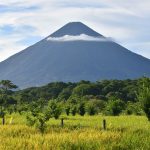Bird Watch – Honduras (04.11.17)
Just as ravens keep watch over the Tower of London, Scarlet Macaws, the national birds of Honduras, stand guard over the magnificent Mesoamerican Mayan site of Copan. Fantastically colourful and full of noise, they settle, squawking, in the surrounding trees, as pervasive as spirits from an ancient world.

Great Green Macaw.
Brilliantly bright and beautiful, their presence gives this most impressive of ancient cities a truly magical ambiance. Which is saying something for a country boasting over 750 bird species spread across 91 national parks, reserves, biospheres and reefs.
So magnificent is Honduras’ natural heritage that the country is regarded as one of the world’s leading wildlife destinations. It is one of nature’s jewels, with vast natural resources boasting 110 mammal species, over 200 reptiles and 6,000 species of vascular plants (including over 600 different orchids).

Copan’s Scarlet Macaws.
All very exciting, even if the delicate balance between safeguarding and enjoying the natural environment is considerably strained by industry and commerce – and in Honduras’s case, deforestation encroaching on the wilderness.
The good news is that Honduras is fast commanding considerable respect as one of the most thrilling bird-watching locations. Visitors can delight in seeing birdlife in varying natural habitats: in wetlands, lowlands, mid-elevation woodland, jungle, cloud forest and coastal water reserves.

Keel-billed Toucan.
I have recently been fortunate enough to visit three of the most significant locations including Copan (with ancient ruins), Pico Bonito National Park and Jeannette Kawas National Park.
Copan, with its star-studded Scarlet Macaw sentries, also offers opportunities to see many other species including other macaws, parrots, toucans, owls, kingfishers, jays, sparrows, warblers and an assortment of birds of prey.

Brown Pelican.
Pico Bonito National Park, set high in the jungle, encompasses eight different ecosystems supporting a huge diversity of resident and migrant species, including my favourites: toucans and humming birds.
The Jeannette Kawas National Park is spread out across a vast inland waterways system that funnels into the Caribbean Sea, via some of the most impressive primary rainforest and mangrove swamp landscapes. Even with my untrained birding eye, I could pick out huge numbers of different species, such as pelican, herons, cormorants, egrets, kingfishers and birds of prey – including hunting fish eagles.

Hermit Humming Bird.
I was also able to visit one of Honduras’s most successful bird rescue ventures – the Macaw Mountain Project. A nature reserve in the Copan region, it offers a rehabilitation environment to birds who have either been captured from poachers or smugglers, kept as pets, or who have suffered injury or habitat loss.
So successful have their recent endeavours been, that when the Copan site’s Scarlett Macaw population nearly disappeared, they could significantly enhance bird numbers by re-introducing macaws that had either temporarily been taken into captivity, or moved from otherwise endangered environments. High on their priority was their immediate introduction to, and involvement of, the local population, without whose help the birds would have little to no chance of survival.

Macaw Mountain Protect – where a high percentage of birds that have been previously domesticated are now unable to exist in the wild.
By inviting residents to visit and share contact with so many of their rescued indigenous birds they have been able to give all stakeholders an opportunity to embrace the safeguarding of what is one of Honduras’ national treasure – birds. And, in particular, their amazing array of Macaws.

Collared Aracari Toucanet.


Crested Caracara Vulture.

Macaw Mountain Project sign – with main focus on embracing the local community.



Macaw Mountain Project feeder.

White-fronted Parrots.

Blue-and-yellow Macaw (rescue bird, as does not occur naturally in Honduras).

Emerald Toucan.

Great Egret and Cormorants.

Blue-and-yellow Macaw.


Great Green Macaw.

Hermit Humming Bird.

Yellow-eared Toucanet.

Streak-backed Oriole.



Pelicans.

Keel-billed Toucan – looking at you, looking at me.


Mealy Amazons.

Thanks, as ever, to Nacho (Ignacio Yúfera – www.iyufera.com) for putting me straight on the various species of bird.







